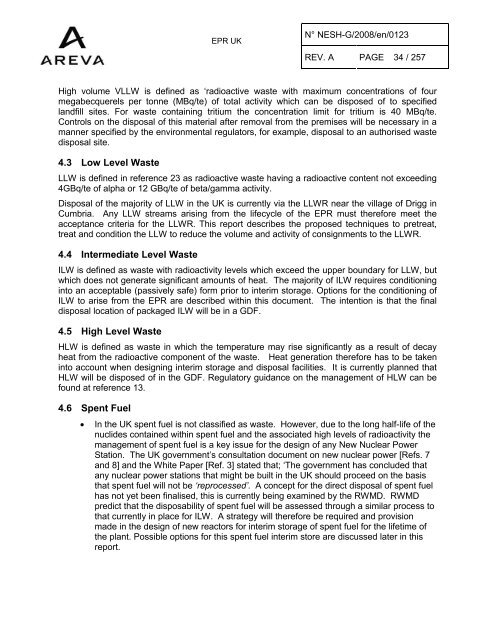Solid Radioactive Waste Strategy Report.pdf - UK EPR
Solid Radioactive Waste Strategy Report.pdf - UK EPR
Solid Radioactive Waste Strategy Report.pdf - UK EPR
You also want an ePaper? Increase the reach of your titles
YUMPU automatically turns print PDFs into web optimized ePapers that Google loves.
<strong>EPR</strong> <strong>UK</strong><br />
N° NESH-G/2008/en/0123<br />
REV. A PAGE 34 / 257<br />
High volume VLLW is defined as ‘radioactive waste with maximum concentrations of four<br />
megabecquerels per tonne (MBq/te) of total activity which can be disposed of to specified<br />
landfill sites. For waste containing tritium the concentration limit for tritium is 40 MBq/te.<br />
Controls on the disposal of this material after removal from the premises will be necessary in a<br />
manner specified by the environmental regulators, for example, disposal to an authorised waste<br />
disposal site.<br />
4.3 Low Level <strong>Waste</strong><br />
LLW is defined in reference 23 as radioactive waste having a radioactive content not exceeding<br />
4GBq/te of alpha or 12 GBq/te of beta/gamma activity.<br />
Disposal of the majority of LLW in the <strong>UK</strong> is currently via the LLWR near the village of Drigg in<br />
Cumbria. Any LLW streams arising from the lifecycle of the <strong>EPR</strong> must therefore meet the<br />
acceptance criteria for the LLWR. This report describes the proposed techniques to pretreat,<br />
treat and condition the LLW to reduce the volume and activity of consignments to the LLWR.<br />
4.4 Intermediate Level <strong>Waste</strong><br />
ILW is defined as waste with radioactivity levels which exceed the upper boundary for LLW, but<br />
which does not generate significant amounts of heat. The majority of ILW requires conditioning<br />
into an acceptable (passively safe) form prior to interim storage. Options for the conditioning of<br />
ILW to arise from the <strong>EPR</strong> are described within this document. The intention is that the final<br />
disposal location of packaged ILW will be in a GDF.<br />
4.5 High Level <strong>Waste</strong><br />
HLW is defined as waste in which the temperature may rise significantly as a result of decay<br />
heat from the radioactive component of the waste. Heat generation therefore has to be taken<br />
into account when designing interim storage and disposal facilities. It is currently planned that<br />
HLW will be disposed of in the GDF. Regulatory guidance on the management of HLW can be<br />
found at reference 13.<br />
4.6 Spent Fuel<br />
· In the <strong>UK</strong> spent fuel is not classified as waste. However, due to the long half-life of the<br />
nuclides contained within spent fuel and the associated high levels of radioactivity the<br />
management of spent fuel is a key issue for the design of any New Nuclear Power<br />
Station. The <strong>UK</strong> government’s consultation document on new nuclear power [Refs. 7<br />
and 8] and the White Paper [Ref. 3] stated that; ‘The government has concluded that<br />
any nuclear power stations that might be built in the <strong>UK</strong> should proceed on the basis<br />
that spent fuel will not be ‘reprocessed’. A concept for the direct disposal of spent fuel<br />
has not yet been finalised, this is currently being examined by the RWMD. RWMD<br />
predict that the disposability of spent fuel will be assessed through a similar process to<br />
that currently in place for ILW. A strategy will therefore be required and provision<br />
made in the design of new reactors for interim storage of spent fuel for the lifetime of<br />
the plant. Possible options for this spent fuel interim store are discussed later in this<br />
report.

















